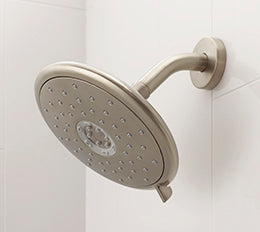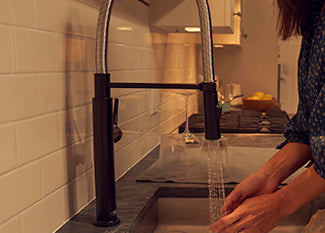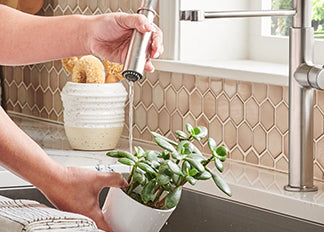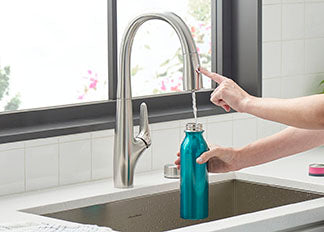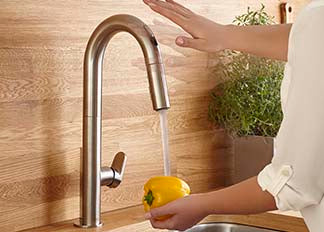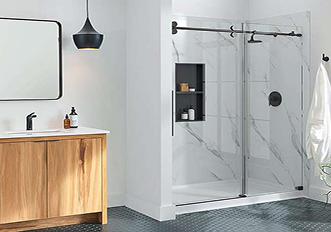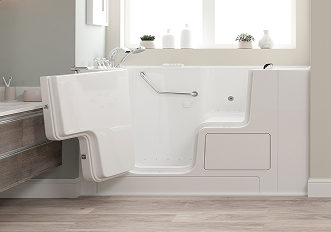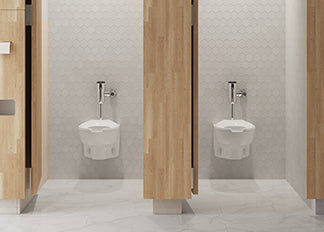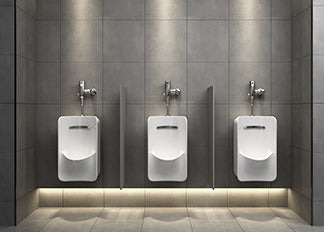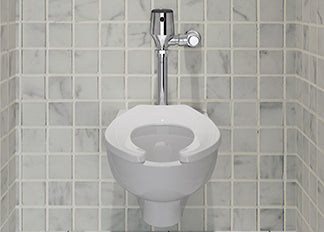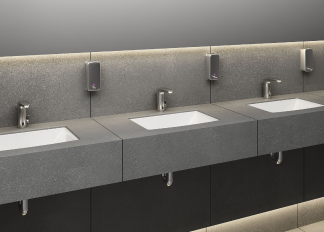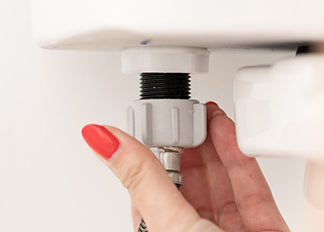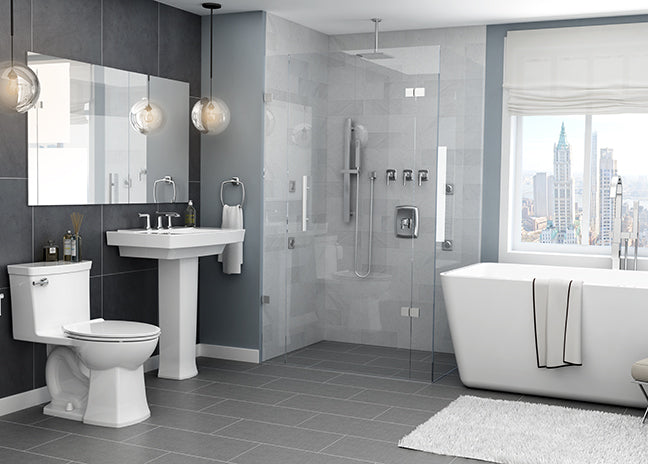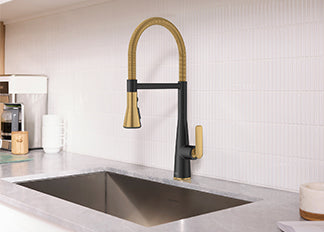How To Ensure A High-Quality User Experience From High-Efficiency Plumbing
Restrooms provide the biggest opportunity to conserve water in commercial buildings. However, property owners and facility managers can be reluctant to adopt the latest high-efficiency fixtures, given the frequent complaints that commercial restrooms can generate:
- These toilets have to be flushed twice.
- The sensor faucets are hard to “activate” and always run cold.
- These urinals have an odor issue.
- The shower pressure is disappointing.
The challenge is that many buildings are still using low-flow technologies from the 1990s or early 2000s that fail to meet user expectations. These first-generation, water-saving fixtures often have internal components that were not reengineered to match the reduced flow rates. With a lifespan of at least 10 years, these outdated fixtures continue to create user skepticism and frustration.
The good news is that today’s low-flow commercial fixtures have been designed and reengineered to deliver high-performance results, including a quality user experience, water savings and reduced maintenance. It all starts with specifying restroom fixtures with the proper commercial design and operation.
Toilets: Flush with Confidence
Toilets that cannot easily remove solid waste with a single flush or that leave behind unpleasant stains are a major concern to commercial maintenance teams and building owners. If users need to flush multiple times, this lack of performance not only negates any water-saving benefits, but also adds frustration and embarrassment to the user experience.
Proper fixture specification will ensure toilets and urinals have been engineered with demanding commercial use in mind. Specifiers should source commercial toilets with these features:
WaterSense Certification – WaterSense-certified toilets use no more than 1.28 gallons per flush (gpf), which is 20% less than the federal standard of 1.6 gpf. The WaterSense label balances conservation with performance, as the U.S. Environmental Protection Agency standard includes “a minimum flush volume of 1.0 gpf to ensure plumbing systems have adequate flow to function effectively.”1 This minimum flush value addresses concerns about sufficient drain line carry to move waste through a building.
Flush Valve – Flush valves with a self-cleaning refill orifice deliver reliable performance by preventing clogs that cause the valve to continuously run and waste water. The self-cleaning refill orifice is especially beneficial for areas with poor water quality that are negatively affected by the accumulation of debris, sand, scale or minerals from hard water. It greatly reduces maintenance, which results in a lower cost of ownership over the lifetime of the product.
In order to work properly, the refill orifice must stay unblocked so that water can flow into the upper valve chamber to pressurize and close the valve. Models with an integral wiper spring clean the refill orifice with each flush, delivering trouble-free and consistent operation over time.
Trapway Size – A wider trapway prevents clogs and reduces service calls. Additional glazing seals the trapway to create a smooth surface that streamlines the passage of waste.
Bowl Wash – Leftover bowl residue compromises the user experience. A good bowl wash should swirl 360 degrees around the entire surface, pushing all materials down to the trapway.
Siphon Jet – This performance feature enhances waste removal. Water is channeled directly from the tank or flushometer to the entrance of the trapway. This jet of water then propels waste out through the trapway, where the extra push of water helps establish a siphon to remove the waste. This design is an advantage over non-siphonic flush toilets, which rely solely on a wash-down design that pushes waste through the trapway.
Water Surface Area – The more generous the water surface area is, the less dry surface there is for materials to cling to, resulting in less maintenance and fewer odors. A larger water surface area can also minimize splashing.
Elongated Bowls – An oval shape is better suited to adult anatomy because it provides space where it is needed most. The additional room also ensures skin does not touch porcelain when the user is in a seated position or using a wiping motion.
Finally, specifiers can ensure the best performance and the most water savings by using hydraulically matched chinaware fixtures and flush valves that have been engineered to work together. This is done by optimizing the discharge from the flush valve to meet the hydraulic requirements of the fixture.
As specifiers work to design restrooms that offer the best possible user experience, it’s important to consider external factors that can impact performance, such as low water pressure, inadequate drain line-carry pipe slope, or extended piping within a building that does not have sufficient supplemental water flow. Further external performance details can be found in the Plumbing Efficiency Research Coalition (PERC 2) report here: http://www.plumbingefficiencyresearchcoalition.org/
Urinals
Low-flow urinals can use as little as one pint per flush. A model with a flushing rim will ensure that water washes down all sides of the urinal, rinsing away any residue that may lead to stains or odors, and resulting in fewer service calls for busy facility professionals.
Water-efficient urinals should also meet ANSI/ASME A112.19.6 for flush performance. This performance standard uses a series of tests to ensure: (1) all sides of the fixture are washed down; (2) the water exchange rate in the trap maintains a specific dilution ratio; and (3) the urinal uses only one gallon or less per flush.
The WaterSense label verifies that water-efficient urinals have not sacrificed performance. While these models use no more than 0.5 gpf and must comply with existing standards, they are also required to be “independently certified to ensure that they flush effectively and have properly functioning drain traps.”3
Showerheads: Shower with Satisfaction
When guests stay at a hotel or shower at a spa, they expect to have an exceptional experience. Part of the allure of showers is to feel pampered. For those on a business trip, a rewarding shower can be an energizing start or the perfect end to a long day. But few things are more disappointing to a guest than to step under a showerhead and have a weak stream of water.
Low-flow showerheads use between 1.5 to 2 gallons per minute (gpm). But water conservation should not require guests to sacrifice a rejuvenating shower experience. If a low-flow showerhead is not living up to guest expectations, it might be suffering from one of these problems:
Pressure Compensation – This essential feature ensures a constant level of water pressure despite a lower flow volume. It’s important to note that a pressure balance valve is not standard on every showerhead model. This type of valve regulates flow by applying a fixed differential pressure, which creates a uniform water-force level using less water.
Spray Force – Separate from water pressure, spray force can make a big difference to user satisfaction. This performance attribute is so important that a minimum level of water force is required for all WaterSense-certified showerheads.4
Spray Coverage – Coverage radius is also critical to a comfortable showering experience. Users may feel like a spray width is inadequate if it is too concentrated or too diffused. WaterSense measures coverage radius in order to verify that the width distribution of a spray pattern falls within a suitable range.4
Spray Patterns – Another way to deliver a rewarding shower experience is to use low-flow models with multiple spray options. Users appreciate choice and are less likely to complain about water-saving fixtures if they can customize their spray pattern. Look for showerheads that can deliver rain shower, massage, concentrated spray, and gentle stream settings.
As with toilets, the showering experience may be connected to factors unrelated to specific fixtures or fittings. Weak water pressure can stem from a number of design and maintenance issues. One common maintenance issue is mineral deposits from calcium or lime. If not periodically cleaned, these deposits can cut off adequate water flow from shower spray holes. Even if a hard water stain is not visible on the showerhead surface, internal screens and nozzles may need to be scrubbed or soaked to restore proper flow.
Bathroom Sink Faucets
In the specification of a low-flow faucet, several features are necessary to deliver the performance level required in commercial restrooms:
WaterSense Certification – WaterSense-approved faucets use no less than 0.8 gpm and no more than 1.5 gpm, which is a 30% reduction over standard 2.2 gpm models. To ensure water-conserving performance, “all faucets and accessories that obtain the WaterSense label have demonstrated both water efficiency and the ability to provide ample flow.”5
Aerators – The purpose of aerators is to achieve a lower flow rate while providing a firm stream of water for users. Three aerator styles are available: standard (uses a small mesh screen to force air into the stream), spray (creates a pattern like a showerhead), and laminar (produces a solid stream).
Ceramic Disc Valve Cartridge – Most faucet valves use ceramic disc cartridges, instead of rubber washers, to start and stop the flow of water. Ceramic discs are much tougher and better equipped to deal with extreme temperatures, and can last for years without needing repairs or replacing. The cartridge protects valve life because the ceramic discs are resistant to sand, rust and hard-water conditions.
Sensor Protection – Some hands-free or motion-activated faucets are factory set for a maximum flow of 0.09 gallon per activation. These metering faucets automatically shut off water at the end of the cycle to reduce consumption and should require little maintenance for the sensor itself. But it is critical that these metering faucets include an in-line filter, which keeps the solenoid valve clean. By preventing drips and leaks, it ensures better reliability. Some models also contain a wiper spring that reduces clogs and run-ons.
Battery Life – Frequent battery outages can undermine the efficacy of automatic low-flow faucets. A standard battery life is only three to four years. Batteries that can operate for five to 10 years ensure continuous water savings with lower maintenance.
Last but not least, an issue that can affect the perceived quality of flow rates is hot-water supply. Users may experience a delay when using hot water and feel reluctant to wash their hands in cold water. In the absence of a closed-loop plumbing system, building owners may need to consider insulating pipes or installing a point-of-use, electric heat booster.
CALGreen Building Code
The 2016 California Green Building Standards Code, known as CALGreen, is the first state-wide regulation of its kind. This comprehensive code “was developed to reduce GHG [greenhouse gas emissions] from buildings; promote environmentally responsible, cost-effective, healthier places to live and work; reduce energy and water consumption; and respond to the environmental directives of the administration.”6
The intent of mandatory measures for water efficiency is to conserve potable water in new or renovated buildings. The code further reasons that reducing water consumption “also results in decreasing the amount of energy needed to transport, process, and treat water, thereby contributing to a reduction of greenhouse gas emissions.”6
In projects over 50,000 square feet, including tenant spaces that consume more than 100 gallons per day, the state code defines maximum allowable flow rates for the following plumbing fixtures and fittings:
Water Closets – The effective flush volume of all water closets shall not exceed 1.28 gpf and be WaterSense-certified.
Urinals – The effective flush volume of wall-mounted urinals shall not exceed 0.125 gpf and floor-mounted urinals shall not exceed 0.5 gpf.
Non-residential Lavatory Faucets – Lavatory faucets shall have a maximum flow rate of no more than 0.5 gpm at 60 psi (pounds per square inch).
Showerheads – A single or hand-held showerhead shall have a maximum flow rate of no more than 2.0 gpm at 80 psi and carry the WaterSense label.
Conclusion: The Reality of Our Decreasing Water Supply
Water conservation is a pressing concern for many commercial properties. In the U.S. alone, up to 40 states will face water shortages by 20248. Because large offices, hospitals, schools, and hotels are large water consumers, it is important to switch to low-flow fixtures to leverage the greatest volume of savings.
The Energy Information Administration (EIA) used data from the most recent Commercial Buildings Energy Consumption Survey (CBECS) to estimate that, in the United States, there are approximately 46,000 commercial buildings greater than 200,000 square feet that use 980 million gallons of water per day8.
“This level represents an estimated 2.3% of the total public water supply in the United States. On average, these buildings used 7.9 million gallons per building, 20 gallons per square foot, and 18,400 gallons per worker in 2012. On a daily basis, they used an average of 22,000 gallons per building, 55.6 gallons per thousand square feet, and 50.1 gallons per worker.”9
Rising utility costs are another reason to prioritize water savings. A report by the Office of Energy Efficiency and Renewable Energy10 calculated an annual price escalation rate, using pricing from more than 60 water utilities and 40 wastewater plants. From 2008 to 2016, the average water rates increased by nearly 40%, and the average wastewater rates rose by 24%. This translates into a 4.1% annual price escalation rate for water and 3.3% increase for wastewater for building owners.
American Standard, part of LIXIL, maker of pioneering water and housing products, offers specifiers, facility managers, and contractors a wide assortment of high-performance, low-flow fixtures and faucets that save water, energy, and money. These include high-efficiency toilets and urinals, water-conserving bathroom sink faucets, and low-flow showerheads. To learn more, visit: americanstandard.com.
Today’s low-flow commercial fixtures have been engineered to achieve water savings without sacrificing user experience and performance.
Water-conserving urinals operate in the range of 0.125 gpf (ultra-high efficiency) to 0.5 gpf (high efficiency).
Hotel guests expect a pleasing shower experience. Low-flow showerheads with multiple spray patterns and pressure compensation will deliver appropriate force and coverage.
Hands-free or motion-activated faucets can be factory set for a maximum flow of 0.09-gallon per activation to reduce consumption.
Specifiers can ensure the best performance and most water savings by using hydraulically matched chinaware, fixtures and flush valves that have been engineered to work together.
REFERENCES:
1 U.S. EPA: Commercial Toilets
2 MaP Testing Protocol
3 U.S. EPA: Urinals
4 U.S. EPA WaterSense® Specification for Showerheads
5 U.S. EPA: Bathroom Fixtures
6 Guide to the 2016 California Green Building Standards Code
7 U.S. EPA: Commercial Toilets; American Standard: Commercial Toilets; U.S. EPA: Urinals; American Standard: Urinals; U.S. EPA: Showerheads; American Standard: Shower Faucets; U.S. EPA: Bathroom Faucets; American Standard: Commercial Faucets
8 U.S. EPA: Water Conservation
9 U.S. Energy Information Administration: 2012 Commercial Buildings Energy Consumption Survey
10 U.S. Department of Energy: Water and Wastewater Annual Price Escalation Rates for Selected Cities across the United States
WaterSense® is a registered trademark of the U.S. Environmental Protection Agency (EPA).

